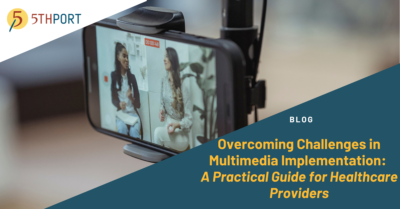Overcoming Challenges in Multimedia Patient Education Implementation: A Practical Guide for Healthcare Providers

“We know patients retain more when they watch a short video. So why aren’t we doing more of it?”
It’s a question we hear quite often.
It’s not that healthcare providers don’t want to use multimedia. It is definitely not about a lack of intention. Everyone agrees that videos are very educational. It helps patients understand procedures, feel less anxious, and actually follow through on care instructions.
But saying yes to multimedia and ACTUALLY executing a roll out? That part is tricky.
In this article, we take a closer look at what’s getting in the way, and offer organizations practical advice to finally make multimedia patient education work.
The Real Barriers to Multimedia Patient Education Rollout
1. Investment in Technology (and Confusion Surrounding it)
Cost is absolutely a factor when it comes to rolling out multimedia patient education in healthcare. But more than that, it’s the complexity of technological systems and the way they might work together, that slows things down. For example,
- Multimedia assets or content should ideally integrate with your EHR/EMR, patient portal, CTMS and more. It isn’t always possible, but it’s a best practice.
- The actual content you create must be mobile-friendly (and implicitly device-agnostic), ADA-compliant, and available in multiple languages.
- The multimedia content (whether avatar videos, videos shot using a green screen or more) is required to be updated as new technology emerges and new processes are developed.
Many teams are wary of introducing another system that they’ll have to manage, sometimes in silos.
2. Staff Readiness and Competing Priorities
Healthcare staff have a real, daily challenge of change management. They balance packed schedules, EMR updates, new compliance requirements, and growing patient loads. So, when a new tool enters the picture (even with clear benefits and ROI) the reaction is often: “I really don’t have time for this right now.”
That hesitation is fair. If the platform isn’t easy to use, or if it feels like extra work without immediate payoff, it’s going to be met with resistance.
Without strong internal champions or clear incentives, even the most promising multimedia solutions can fade into the background. Adoption doesn’t go so well if you just tell teams to use it. It comes from making that tool the easiest and most effective option for them.
3. Patient Access and Equity Gaps
Multimedia is only effective if patients actually engage with it. Obvious right? Not really, since this is where many implementations fall short.
Not every person has access to the internet. Some people rely solely on mobile data. Others may not feel confident navigating digital tools at all.
And then there’s the matter of language – or rather, the lack of appropriate language support. If a video or document is only available in English, it instantly excludes a significant portion of patients in multilingual communities. The same goes for people with visual, auditory, or cognitive impairments. Without captioning, voiceovers, or alternative formats, multimedia can unintentionally widen the very gap it’s trying to close.
Even IF all of that was taken care of, timing is everything. It isn’t helpful if a patient receives a video 2 hours before radiation therapy, for example. Send it too early or too late (especially with little to no context) risks that it is ignored altogether.
We reiterate what we mentioned before. Multimedia isn’t about a checkbox saying ‘video sent’. It is about comprehension, and that takes intentional design that healthcare providers understandably think technology vendors need to keep first and foremost in mind.
How do you make multimedia patient education work, without complicating it?
1. Start Small
You don’t have to roll out multimedia across your entire system at once.
- Begin where it matters most: informed consent, pre-op instructions, post-discharge care.
- Choose one department or workflow. Ideally where there are champions already.
- Identify 3 goals you want to tackle over a period of 60-90 days. Is it to increase teach back scores? Is it to improve overall patient satisfaction scores? Is it to measure operational efficiencies? Is it to give time back to nurses and doctors?
- Measure the results of your pilot program, and then expand accordingly.
When you have a plan for targeted use, it automatically equates to faster adoption rates and a clearer ROI.
2. Make it Easy
Adoption depends on simplicity for front line workers, especially nurses, who are the true influencers and end users. Without their buy-in, adoption is stalled.
- Choose simple platforms that think about the user experience first.
- Give staff tools to assign videos, track completion, and view patient understanding all in one place.
- Offer short internal training or designate a “multimedia lead” in each unit to help others get started.
Remember: if it feels like a burden, it probably is. And the technology won’t last.
3. Design for Real-World Patients
Patients have things they have to do, people they have to see and places they have to go. They’re always on the move. Which means the quality of care they receive has to be as well. They’re watching videos in waiting rooms, reviewing instructions from their couch, or trying to remember what their doctor said while riding home from an appointment.
To be effective, multimedia in patient care needs to meet patients where they already are – not where they hope they may be. This means:
- Designing multimedia content for phones and tablets first, not desktops and laptops.
- Using everyday lingo to communicate, and at a level (usually 8th grade) that is easy for everyone to consume.
- Offer the video in multiple “formats” (multilingual voiceovers, subtitles and translations) because everyone has different learning styles.
- Browser-based videos are far more accessible than videos that need portals or login details to access.
- Adding in visual storytelling cues and animations helps patients envision their treatment protocol and better prepare them for discussions they will have with their healthcare providers.
Don’t Forget to Measure EVERYTHING Patient Education – and be Honest about What’s Not Working
If you want multimedia to actually improve patient understanding, you have to move past gut instinct and start looking at the numbers.
It’s not enough to say, “We sent the video,” or “Patients have access to the portal.” Access doesn’t equal engagement, and engagement doesn’t always equate with comprehension.
That’s why the most successful multimedia implementations are grounded in metrics. Take 5thPort for example. The difference is night and day when it comes to measuring metrics like:
- Who opened the video?
- How long did they watch it for?
- Did they complete the assigned content before their visit?
- Did their quiz or teach-back responses show true understanding?
- Were follow-up questions reduced as a result?
These metrics help you spot what’s working and where the breakdowns are. If most patients drop off halfway through a five-minute video, maybe the content needs to be shorter. If a certain department sees consistently lower engagement across the board, maybe they need a different rollout approach, or more staff support.
The key is being open to what the data tells you, even if it uncomfortable.
And here’s the good news: once you start tracking the right things, it becomes easier to make the case for expansion. You’re not just saying “we think this is helpful.” You’re showing that patients are more prepared, clinicians are saving time, and overall care quality is improving.
The real power of multimedia isn’t just in the format; it’s in the feedback. And the more honest you are with your metrics, the faster you’ll see results that matter.
Ready to evaluate multimedia and see what it could look like for your organization?
Schedule a 5thPort demo today and explore how we can work together to design multimedia education videos with real patients, real workflows, and real results in mind.




